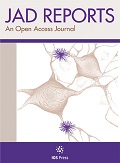Authors: Chakrabarti, Sudipta | Prorok, Tim | Roy, Avik | Patel, Dhruv | Dasarathi, Sridevi | Pahan, Kalipada
Article Type:
Research Article
Abstract:
Background: Neuroinflammation is a recognized aspect of Alzheimer’s disease (AD) and other neurological illnesses. Interleukin 1 receptor antagonist (IL-1Ra) is an anti-inflammatory molecule, which inhibits inflammatory molecules in different cells including brain cells. However, mechanisms for upregulating IL-1Ra in brain cells are poorly understood. Objective: Since aspirin is a widely available pain reliever that shows promise beyond its known pain-relieving capacity, we examined whether aspirin could upregulate the IL-1Ra in the brain. Methods: We employed PCR, real-time PCR, western blot, immunostaining, chromatin immunoprecipitation (ChIP), and lentiviral transduction in glial cells. 5xFAD mice, an animal model of
…AD, were treated with aspirin orally via gavage. Results: Aspirin increased the expression of IL-1Ra mRNA and protein in primary mouse astrocytes and mouse BV-2 microglial cells. While investigating the mechanism, we found that the IL-1Ra gene promoter harbors peroxisome proliferator response element (PPRE) and that aspirin upregulated IL-1Ra in astrocytes isolated from peroxisome proliferator-activated receptor-beta knockout (PPARβ–/– ), but not PPARα–/– , mice. Moreover, we observed that aspirin bound to tyrosine 314 residue of PPARα to stimulate IL-1Ra and that aspirin treatment also increased the recruitment of PPARα to the IL-1Ra promoter. Accordingly, aspirin increased IL-1Ra in vivo in the brain of wild type and PPARβ–/– , but not in PPARα–/– mice. Similarly, aspirin treatment also increased astroglial and microglial IL-1Ra in the cortex of 5xFAD, but not 5xFAD/PPARα–/– mice. Conclusion: Aspirin may reduce the severity of different neurological conditions by upregulating IL-1Ra and reducing the inflammation.
Show more
Keywords: 5xFAD model, aspirin, astrocytes, IL-1Ra, microglia, PPARα
DOI: 10.3233/ADR-210026
Citation: Journal of Alzheimer's Disease Reports,
vol. 5, no. 1, pp. 647-661, 2021





